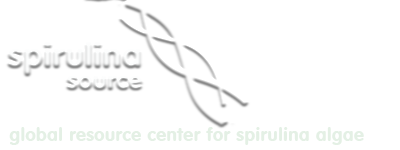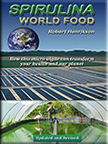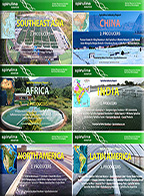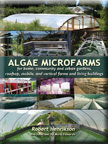REFERENCES AND ABSTRACTS BY HEALTH CATEGORY
Spirulina scientific reference library. Over 100 references covering 45 years of international research.
Click on PDF Download button for free pdf file.
![]() Potential of Spirulina Platensis as a Nutritional Supplement in Malnourished HIV-Infected Adults in Sub-Saharan Africa. by M. Azabji-Kenfack et al. 1996. Pub. by Nutrition and Metabolic Insights 2011:4. Cameroon.
Potential of Spirulina Platensis as a Nutritional Supplement in Malnourished HIV-Infected Adults in Sub-Saharan Africa. by M. Azabji-Kenfack et al. 1996. Pub. by Nutrition and Metabolic Insights 2011:4. Cameroon.
Background: Malnutrition is a major global public health issue and its impact on communities and individuals is more dramatic in Sub-Saharan Africa, where it is compounded by widespread poverty and generalized high prevalence of human immunodeficiency virus (HIV). Therefore, malnutrition should be addressed through a multisectorial approach, and malnourished individuals should have access to nutritional rehabilitation molecules that are affordable, accessible, rich in nutrient and efficient. We thus assessed the efficacy of two affordable and accessible nutritional supplements, spirulina platensis versus soya beans among malnourished HIV-infected adults.
Conclusion: We therefore conclude in this preliminary study, firstly, that both spirulina and soja improve on nutritional status of malnourished HIV-infected patients but in terms of quality of nutritional improvement, subjects on spirulina were better off than subjects on soya beans. Secondly, nutritional rehabilitation improves on immune status with a consequent drop in viral load but further investigations on the antiviral effects of this alga and its clinical implications are strongly needed.
Spirulina – Production & Potential.
by Ripley D. Fox. 1996. Pub. by Editions Edisud, La Calade, R.N.7, 13090 Aix-en-Province, France. Tel: 42216144; Fax: 42215620.
This book gives the most complete and practical information on growing spirulina. It should be consulted by health authorities and development decisionmakers, by spirulina growers and it can be used as a teaching text in universities. Dr. Fox explains the history of the cyanobacteria, Arthrospira platensis, popularly known as the blue-green algae spirulina… its composition, growth requirements and methods for managing the culture (from village level artisanal production to large scale industrial farms). Health benefits are described, with emphasis on its usefulness for combatting malnutrition. Giant farms using seawater are proposed for providing spirulina as a food supplement for the millions of malnourished children living today. Dr. Fox sees spirulina as a million dollar commodity in the near future.
Algoculture: Spirulina, hope for a hungry world.
by Ripley D. Fox. 1986. Pub. by Edisud, Aix-en-Province, France (in French).
Clinical experimentation with spirulina.
by R. Ramos Galvan. 1973. National Institute of Nutrition, Mexico City, Mexico (in Spanish).
![]() Current knowledge on potential health benefits of spirulina.
Current knowledge on potential health benefits of spirulina.
by Amha Belay, Yoshimichi Ota, Kazuyuki Miyakawa and Hidenori Shimamatsu. 1993. Pub. in Journal of Applied Phycology, 5:235-241. USA.
Spirulina is a microscopic filamentous alga that is rich in proteins, vitamins, essential amino acids, minerals and essential fatty acids like gammma-linolenic acid (GLA). It is produced commercially and sold as a food supplement in health food stores around the world. Up to very recently, the interest in Spirulina was mainly in its nutritive value. Currently, however, numerous people are looking into the possible therapeutic effects of Spirulina. Many pre-clinical studies and a few clinical studies suggest several therapeutic effects ranging from reduction of cholesterol and cancer to enhancing the immune system, increasing intestinal lactobacilli, reducing nephrotoxicity by heavy metals and drugs and radiation protection. This paper presents a critical review of some published and some unpublished data on therapeutic effects of spirulina.
Effectiveness of spirulina algae as food for children with protein-energy malnutrition in a tropical environment.
by P. Bucaille. 1990. University Paul Sabatier, Toulouse, France. Oct. 1990. Zaire. (in French).
Food value of spirulina in humans.
by C. Sautier and J. Tremolieres. 1976. Pub. in Ann. Nutrition Alim., 30:517-534. France (in French).
Health Benefits of Spirulina.
by Denise Fox. 1993. In Spirulina, Algae of Life. April 1993. Bulletin No. 12. Pub. by Institute Oceanographique, Monaco.
Large scale nutritional supplementation with spirulina alga.
by C.V. Seshadri. 1993. All India Coordinated Project on Spirulina. Shri Amm Murugappa Chettiar Research Center (MCRC) Madras, India.
A one year feeding program with 5,000 pre-school children showed a symptom of Vitamin A deficiency, “Bitot’s spot”, decreased from 80% to 10%. These rural children near Madras consumed 1 gram of spirulina a day for at least 150 days. This small amount provided the daily requirement of beta carotene (Vitamin A) which can help prevent blindness and eye diseases. In another study with 400 school children, a daily dose of beta carotene from spirulina increased their Vitamin A status to the same level as those administered pure Vitamin A. Spirulina was given to children in a unique way: extruded noodles, sweetened with sugar to preserve the beta carotene. Called “Spiru-Om”, it was well accepted by the children. This project was sponsored by the Indian Government.
Observations on the utilization of spirulina as an adjuvant nutritive factor in treating some diseases accompanied by a nutritional deficiency.
by V. Fica, et al. 1984. Clinica II Medicala, Spitalui Clinic, Bucuresti. Med. Interna 36 (3). Romania. (in Romanian).
Spirulina tablets were given to 21 patients with various nutritional deficiencies. They had suffered weight loss in conjunction with gastric resection, tubercular infection, chronic pancreatitis and gastritis, rheumatoid arthrtis, anemia and disbetes mellitus. With spirulina, the patients gained weight and their proteinograms improved.
Spirulina in Jiangxi China.
by Miao Jian Ren. 1987. Academy of Agricultural Science. Presented at Soc. Appl. Algology, Lille France Sep. 1987. China.
In Nanjing Childrens Hospital, 27 children, 2-6 years old, recovered in a short period from bad appetite, night sweats, diarrhea and constipation from a baby nourishing formula containing 1.5g spirulina, 12g baked barley sprout, Vitaimn B1 and Zinc. The clinical effects showed spirulina is a genuine health food for children.
The study on curative effect of zinc containing spirulina for zinc deficient children.
by Wen Yonghuang, et al. 1994. Capital Medical College, Beijing. Presented at 5th Int’l Phycological Congress, Qingdao, June 1994. China.
Spirulina with a high zinc content may be twice as effective as a zinc supplement in curing zinc deficiency in children. The effective dose of zinc from spirulina was 2 to 4 times less than the zinc from a common supplement, zinc sulfate. More than two times the children were cured with high zinc spirulina. One hundred children were diagnosed as suffering from zinc deficiency. For a three month period, 50 children were given zinc sulfate and 50 were given spirulina tablets. Doctors concluded spirulina’s effect was much better than zinc sulfate. Spirulina had no side effects and was easy to administer for long periods of time. They theorized that high zinc spirulina had many bioactive and nutritious substances which improved mineral absorption, general health and the immune system.




